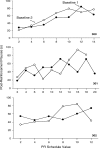Aggression as positive reinforcement in mice under various ratio- and time-based reinforcement schedules
- PMID: 19794833
- PMCID: PMC2648522
- DOI: 10.1901/jeab.2009.91-185
Aggression as positive reinforcement in mice under various ratio- and time-based reinforcement schedules
Abstract
There is evidence suggesting aggression may be a positive reinforcer in many species. However, only a few studies have examined the characteristics of aggression as a positive reinforcer in mice. Four types of reinforcement schedules were examined in the current experiment using male Swiss CFW albino mice in a resident-intruder model of aggression as a positive reinforcer. A nose poke response on an operant conditioning panel was reinforced under fixed-ratio (FR 8), fixed-interval (FI 5-min), progressive ratio (PR 2), or differential reinforcement of low rate behavior reinforcement schedules (DRL 40-s and DRL 80-s). In the FR conditions, nose pokes were maintained by aggression and extinguished when the aggression contingency was removed. There were long postreinforcement pauses followed by bursts of responses with short interresponse times (IRTs). In the FI conditions, nose pokes were maintained by aggression, occurred more frequently as the interval elapsed, and extinguished when the contingency was removed. In the PR conditions, nose pokes were maintained by aggression, postreinforcement pauses increased as the ratio requirement increased, and responding was extinguished when the aggression contingency was removed. In the DRL conditions, the nose poke rate decreased, while the proportional distributions of IRTs and postreinforcement pauses shifted toward longer durations as the DRL interval increased. However, most responses occurred before the minimum IRT interval elapsed, suggesting weak temporal control of behavior. Overall, the findings suggest aggression can be a positive reinforcer for nose poke responses in mice on ratio- and time-based reinforcement schedules.
Keywords: CFW mice; aggression; differential reinforcement of low rate; fixed-interval; fixed-ratio; nose poke; positive reinforcement; progressive-ratio.
Figures










Similar articles
-
Effects of drugs on response duration differentiation. VI: differential effects under differential reinforcement of low rates of responding schedules.J Pharmacol Exp Ther. 1997 Jun;281(3):1368-80. J Pharmacol Exp Ther. 1997. PMID: 9190873
-
Aggressive behavior as a reinforcer in mice: activation by allopregnanolone.Psychopharmacology (Berl). 2002 Oct;163(3-4):459-66. doi: 10.1007/s00213-002-1211-2. Epub 2002 Aug 27. Psychopharmacology (Berl). 2002. PMID: 12373446
-
A laboratory comparison of two variations of differential-reinforcement-of-low-rate procedures.J Appl Behav Anal. 2014 Summer;47(2):314-24. doi: 10.1002/jaba.114. Epub 2014 Apr 17. J Appl Behav Anal. 2014. PMID: 24740374
-
Neural basis of operant behaviors maintained on the differential-reinforcement-of-low-rate (DRL) schedule in rodents.Brain Res Bull. 2022 Jul;185:1-17. doi: 10.1016/j.brainresbull.2022.04.003. Epub 2022 Apr 16. Brain Res Bull. 2022. PMID: 35439572 Review.
-
A theory of behaviour on progressive ratio schedules, with applications in behavioural pharmacology.Psychopharmacology (Berl). 2012 Aug;222(4):549-64. doi: 10.1007/s00213-012-2771-4. Epub 2012 Jul 3. Psychopharmacology (Berl). 2012. PMID: 22752382 Review.
Cited by
-
Hypothalamic control of male aggression-seeking behavior.Nat Neurosci. 2016 Apr;19(4):596-604. doi: 10.1038/nn.4264. Epub 2016 Mar 7. Nat Neurosci. 2016. PMID: 26950005 Free PMC article.
-
Compulsive Addiction-like Aggressive Behavior in Mice.Biol Psychiatry. 2017 Aug 15;82(4):239-248. doi: 10.1016/j.biopsych.2017.03.004. Epub 2017 Mar 17. Biol Psychiatry. 2017. PMID: 28434654 Free PMC article.
-
Ventromedial Hypothalamus and the Generation of Aggression.Front Syst Neurosci. 2017 Dec 20;11:94. doi: 10.3389/fnsys.2017.00094. eCollection 2017. Front Syst Neurosci. 2017. PMID: 29375329 Free PMC article. Review.
-
Neurocircuitry of aggression and aggression seeking behavior: nose poking into brain circuitry controlling aggression.Curr Opin Neurobiol. 2018 Apr;49:184-191. doi: 10.1016/j.conb.2018.02.013. Curr Opin Neurobiol. 2018. PMID: 29524848 Free PMC article. Review.
-
Decoding ventromedial hypothalamic neural activity during male mouse aggression.J Neurosci. 2014 Apr 23;34(17):5971-84. doi: 10.1523/JNEUROSCI.5109-13.2014. J Neurosci. 2014. PMID: 24760856 Free PMC article.
References
-
- Couppis M.H, Kennedy C.H. The rewarding effect of aggression is reduced by nucleus accumbens dopamine receptor antagonism in mice. Poster presented at the annual meeting of the Society for Neuroscience conference, San Diego, CA 2007, November. - PubMed
-
- Couppis M.H, Kennedy C.H. The rewarding effect of aggression is reduced by nucleus accumbens dopamine receptor antagonism in mice. Psychopharmacology. 2008;197:449–456. - PubMed
-
- Couppis M.H, Kennedy C.H, Stanwood G.D. Differences in aggressive behavior and in the mesocorticolimbic DA system between A/J and BALB/cJ mice. Synapse. 2008;62:715–724. - PubMed
MeSH terms
LinkOut - more resources
Full Text Sources
Research Materials

